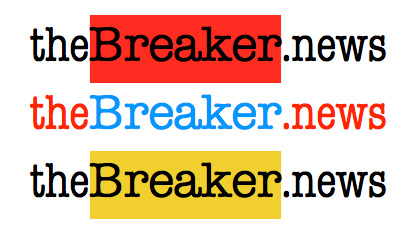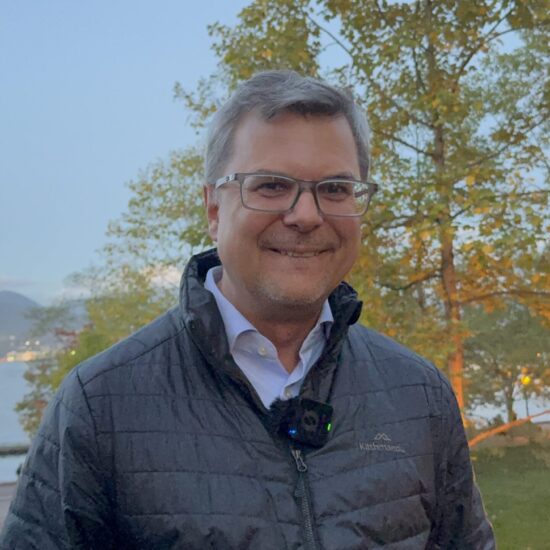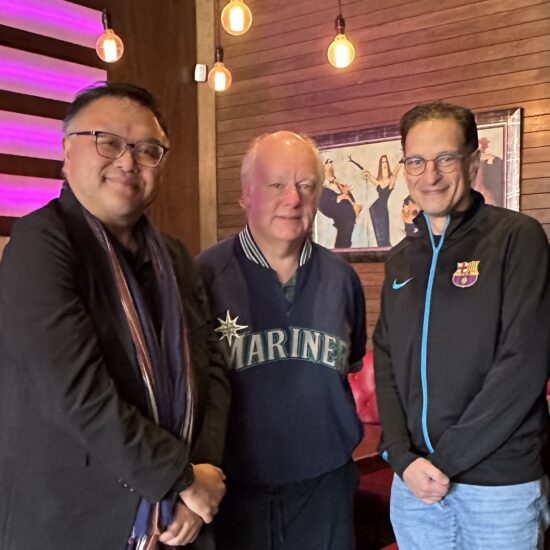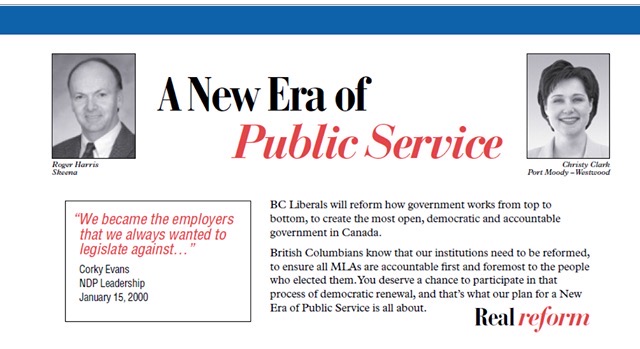
The Pew Research Centreʼs State of the Media survey found one-third of respondents deserted a news outlet — they werenʼt getting the news and information like they used to. Pew blamed “a news industry that is more undermanned and unprepared to uncover stories, dig deep into emerging ones or to question information put into its hands.”
“At the same time, newsmakers and others with information they want to put into the public arena have become more adept at using digital technology and social media to do so on their own, without any filter by the traditional media.”
“They are also seeing more success in getting their message into the traditional media narrative.” In 2008 there was “Joe the Plumber.” In 2012, it was “Binders Full of Women.” What will be the meme for B.C. 2013?
The Pew report said campaign reporters were acting as “megaphones” for politicians and partisans, instead of filtering and putting in context the issues with a critical eye. Has the noble goal of objectivity gone awry? Or did it ever exist? Remember what Hunter S. Thompson said: “With the possible exception of things like box scores, race results, and stock market tabulations, there is no such thing as Objective Journalism. The phrase itself is a pompous contradiction in terms.”
Speaking of box scores and race results. My journey on the FOI trail began because of sport. Because of the Olympics. I entered B.C. Place Stadium on a September day in 1998. Ex- Canucks owner Arthur Griffiths had a new job, bidding for the Vancouver 2010 Olympics.
Can you imagine? That was the slogan. Slowly, but surely, sport took a back seat. The $6 billion to $8 billion Olympics became a story of politics and economics. Security and insecurity. Poverty and wealth.
Sidney Crosbyʼs golden goal kept Gordon Campbell and John Furlong away from a Royal Commission. Auditors General in Ottawa and Victoria dropped their pencils and went onto other things.
I wrote an e-book about it all — called Red Mittens & Red Ink: The Vancouver Olympics. The Vancouver 2010 Olympics were just a colder version of the Montreal 1976 Olympics. We also had Olympic Village and Olympic Stadium scandals.
VANOC convinced Vancouverʼs city manager, Penny Ballem, to hide the financial statements and board minutes from the public in the city archives until 2025.
There were victories along the way. In 2008, Sean Holman got his hands on documents from Washington State that showed how BC Liberal backroom boys Mark Jiles and Patrick Kinsella were hired by the State of Washington to lobby the B.C. government for Olympic-related contracts. Their resume revealed new information about their clients and it boasted that they were: “in the heart of downtown Vancouver, while at the same time… a presence in the provincial capital of Victoria and a foot into the Vancouver 2010 Organizing Committee.” They offered to set-up meetings with John Furlong, Jack Poole and cabinet ministers.
David Eby and the B.C. Civil Liberties Association gained documents that showed how the RCMP would turn downtown Vancouver into an armed fortress with street closures galore.
After the Games, CBCʼs Fifth Estate got the famous March 2009 email sent by John Furlong to senior VANOC executives. The International Luge Federation was worried that the Whistler Sliding Centre was too fast and someone could get hurt. “An athlete gets badly injured or worse and I think the case could be made we were warned and did nothing,” Furlong wrote. They were warned. An athlete died. The question remains: did they do anything?
I had a few scores along the way.
Remember how they called them the Green Games? David Suzuki — “Professor Nature of Things” — gave VANOC a bronze medal rating before the Games even began. The only thing at the Olympics truly green were the Olympic rings at the venues.
VANOC hired an American company called Gameday for more than $50 million to hire 1,000 diesel buses from as far away as Florida. An FOI to city hall showed that only 300 of the buses had permits by the first weekend of the Games.
Afterward, I did an FOI to the B.C. Passenger Transportation Branch for temporary licence records for all the companies and their buses. Using Google maps, I estimated they were driven 5.1 million kilometres to and from Vancouver. Thatʼs 127 times around the equator. In the end, the bus contract cost VANOC an extra $40 million.
Then there was hickory, dickory, VANOC. Mice hitched a ride on straw imported from Oregon to Cypress Mountain. Biologists were hired to trap the mice and to get rid of invasive plants like Japanese knotweed and scentless chamomile. Itʼll cost $160,000 through 2015.
The symbol of the Games, the Olympic cauldron at Jack Poole Plaza, was a gas guzzler. The VANOC communications machine didnʼt want to tell us how much natural gas it burned while trying to sell the notion that the Games were green. They turned it on again for Canada Day 2010 for 13 hours and, via FOI, I found it used 7.6 Gigajoules per hour. I did the math. Over 25 days of the Olympics and Paralympics, it burned more than 4,500 Gigajoules — enough to power 56 houses for a year.
Had the Olympic flame gone out of control at the opening ceremony, it could have been the biggest disaster in Olympic history. I found out through FOI that neither VANOC nor B.C. Place Stadium had conducted a fire drill for more than two years in the stadium. They tested the fire bells, but they did not do a mock evacuation. WorkSafeBC says you need to do it annually. The cauldron arm stuck below the stage on opening night. Can you imagine if it had been spewing flames?
B.C. Place Stadiumʼs slogan used to be Big Dreams Live Here. I became the biggest nightmare for management and B.C. Pavilion Corporation, the Crown corporation that runs it. I have reported stories that run the gamut, from the damage caused by grease leaking on the new roof to the increased costs of electricity since it reopened. I act without malice; I only want to help the people who fund the Crown corporation to know more about it, because PavCo seems unable or unwilling to do so on its own.
It all began on January 5, 2007. A cold, stormy day. The first Friday of the new year. The world junior hockey championship was on TV. A friend called me. “The roof of B.C. Place Stadium has collapsed!”
I was working for 24 Hours Vancouver at the time. I had a source who gave me the phone number for the control room. Lo and behold, the PR agent was already there and she told me to come down for a news conference. PavCo had its spin, a euphemism called “controlled deflation.” The cousin of “wardrobe malfunction” and “incident of concern,” perhaps? Wind and the 24-year-old roof fabric were the villains. But were they really? It turned out they ignored five alarms, warning that snow was on the roof. All they had to do was heat the roof and it would melt. Out of desperation, the air pressure was spiked, causing an avalanche that cut a hole in the roof. Voila! B.C. Place was supposed to get only $3.8 million for Olympic fix-ups. Now the price was going through the roof.
In May 2006, Liberal minister Olga Ilich said the roof was in fine condition — it could last 15 to 20 more years. But a month later, as we found out from a Vancouver Sun FOI, the tourism ministry was being asked for renovations because of “worn-out assets” mentioned in a 15-page report — of which 14 pages were censored.
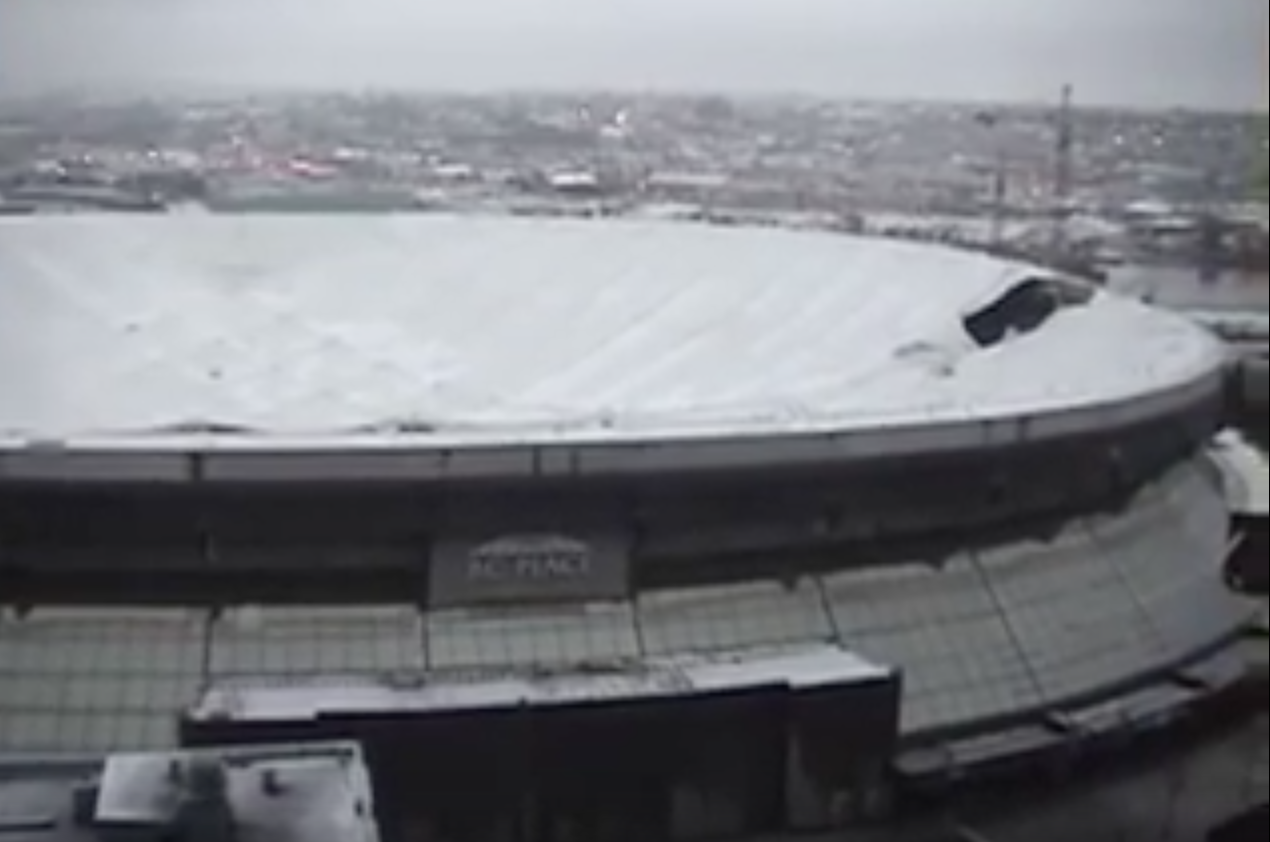
B.C. Place’s collapsed roof, as seen from the Hampton Inn.
By the end of 2007, Gordon Campbell and Jack Pooleʼs buddy David Podmore was running PavCo again and he wanted to renovate. Podmore started small. Construction documents I got in 2010 showed it was going to cost $75 million, with a replaced roof. Then it crept up to $100 million. Ideas were flying fast and furiously. Letʼs replace it before the Olympics and make it retractable, like a stadium in Frankfurt, Germany, for $253 million!
It would have been done in time for the Olympics, but experts estimated it would be finished two weeks before opening ceremony. So it was delayed. The budget was going to be $365 million in January 2009. By October 2009, it was $563 million.
The government kept the renovation business plan secret, by calling it a cabinet document. Never approved by the Legislature or the voters. If a big earthquake hits tomorrow, St. Paulʼs Hospital could be a pile of bricks. But B.C. Place will be standing.
Itʼs too bad the stadium didnʼt have better walkie-talkies or first aid coverage after the B.C. Lions won the Western Final in 2006. Janitor Pritam Kaur Sandhu was cleaning menʼs washrooms at section 229. Sandhu was in her 60s and complained of a severe headache. She collapsed and was taken away by ambulance to Vancouver General Hospital, where she died. WorkSafeBC says serious injuries or deaths must be reported immediately. It wasnʼt. A worker finally blew the whistle 11 months later. Sandhuʼs employer was found in violation, but B.C. Place was not cited. By FOI, I found stadium security head Eric Borglund wrote a report a week after the death, but it was kept away from WorkSafeBC. The stadiumʼs Health and Safety Committee also kept quiet.
The same management team in charge when Sandhu died and when the roof ripped and collapsed still runs the stadium. Donʼt ask me how. But you can ask me how the government justified the renovation, which kept Liberal friendly construction companies busy when work was done on the main Olympics venues.
The B.C. Lions only 10 games a year at home. PavCo needed the Whitecaps, to justify the expenditure, with an additional 20 event dates. Whitecaps managing owner is Greg Kerfoot, a reclusive technology tycoon who saved the team in 2002 when it was about to fold. He has never done an interview.
This is a man who built a $14 million lakeside mansion in Whistler, including an NHL sized hockey rink with seats for 100. His son, Alexander, was drafted by the New Jersey Devils last year. In 2005,
Kerfoot wanted to build a stadium over train tracks next to Gastown. City hall was lukewarm. Tower developers want that land. Gordon Campbell came to the rescue. He OKʼd the B.C. Place renovation and promised $17.5 million for the Whitecaps to build a training centre in Delta. That was announced during the 2009 election, but parachute candidate Wally Oppal lost to independent Vicki Huntingdon. Delta council eventually killed the proposal.

B.C. Place Stadium was supposed to become Telus Park, but Clark nixed the naming rights deal.
Kerfootʼs friend Christy Clark came to power in 2011. His Bell sponsored Whitecaps moved into B.C. Place, which was supposed to be renamed for Telus.
Telus had already scored a $1 billion, 10-year telecommunications deal. Bell, Rogers and Shaw were furious, according to the FOIs. Later that year, PavCo released the Whitecaps and Lions contracts to me. But the dollar figures were censored. What are the teams paying to play in the False Creek palace? I’m led to believe it’s a royalty on ticket sales, but is it fair market value? Iʼm trying to find out.
B.C. Place is a public monopoly — there is no other stadium up to Major League Soccer or Canadian Football League standards in B.C. And they are the only franchises in B.C. Last September 6, the government gave the Whitecaps $14.5 million for a training centre at UBC — plus another $3 million when they need it. It was the day after Rich Coleman became Deputy Premier. The Minister of Liquor, Gambling, BC Hydro, Natural Gas and was now B.C. Pavilion Corporationʼs minister. UBC is in the premierʼs riding. Itʼs called the National Soccer Development Centre, but no federal dollars.
So I started the FOI trail. What are the Lions and Whitecaps paying for at B.C. Place? Five months and a couple of PavCo third-party consultation delays later, PavCo gave me lists of transactions. But all the dollar figures were gone. So I made a supplemental FOI request.
Who was this third-party? Did the Whitecaps object? Did the Lions object? Did PavCo consult a lawyer? Did the PavCo board — which meets in secret — say no? Did a deputy minister or a certain minister get involved? The day after Valentineʼs Day, PavCo told me it was making a section 43 application to shut down my FOI requests.
They claimed I was being frivolous and vexatious. I wrote a letter immediately to PavCo, asking for it to reconsider and rescind. PavCo has still not replied. I asked PavCoʼs chairman Peter Fassbender and one of its directors, Suzanne Anton to help. Fassbender is the mayor of Langley city. Anton was a city councillor who wanted to be mayor of Vancouver. She often complained about city hall secrecy.

Who really runs the BC Liberal government? (Photoshop/Facebook)
I even made a goodwill move to close two files — I wanted to see every invoice connected to the line items in the list, but I appealed to OIPC instead. I wrote an urgent letter to Commissioner Elizabeth Denham.
It created a buzz in the mainstream media and on social media. The NDPʼs Spencer Chandra Herbert and Doug Routley challenged Rich Coleman in Question Period on Feb. 19. Coleman carefully did not speak my name. His staff gave him talking points, including statistics: I made 66 FOI requests since April 2012 — 86% of the total received by PavCo.
Theyʼre mostly for board minutes, management minutes, worker safety committee minutes and lists of contracts. I also want to know whoʼs burning the Olympic cauldron and whether the new half-billion-dollar roof is working and whether itʼs paying off.
The Canadian Taxpayers’ Federation publicly supported me.
The Office of the Information and Privacy Commissioner scheduled an inquiry. The onus was on PavCo to prove I was what they said. Their deadline was March 19. Mine was March 26. The inquiry was to close April 8.
But PavCo had to make it interesting. At 5:38 P.M. on March 15 — a Friday night, the Ides of March, two working days before its submission deadline — it asked for an extension by 10 working days to April 4. It wanted to “ensure that proper review of the submission can be undertaken by the Head.” The head of the Crown corporation, head of the board or head of ministry? I opposed, but OIPC granted the extension. April 4 it was. My reply was due April 11 — today! Maybe, just maybe I might get something before the election.
Lo and behold — on April 4 at 3:15 p.m. — I got an email from PavCo. It withdrew the application, but tried to make it look like it was the victim of a technicality. PavCo wanted another extension to consult a lawyer. OIPC refused. PavCo can dish it out. But it canʼt take it. On April 5, my FOI requests were reactivated. The original due date was March 22. The new due date is May 23 — 9 days after the election.
So I won the battle with PavCo. But we all lost a war.
This week Julian Assangeʼs WikiLeaks began to leak again. But another set-back for us in British Columbia. We find out that Shom Sen, an assistant deputy minister of international trade and investment, ordered staff to delete emails and shred hard copies. Just call it transitory and keep it secret. Shades of Order of B.C. recipient Ken “I delete email all the time, as fast as I can” Dobell. But at least we know. Now we can do something about it.
So much happened since February 27 — when Pink Shirt Day became red-face day for the BC Liberals.
The NDP exposed the Multicultural Outreach Strategy election playbook, devised on government time for the Liberal party. Is this why Family Day happened on Chinese new year weekend? Is this why we got the Times of India Film Awards? Commissioner Denham found the Liberals were running an “oral government” and urged a “duty to document” law be enacted.
The in-house report on the Quick Wins scandal confirmed Liberals were using GMail to keep information away from us. And Commissioner Denham ruled that private email containing government communications is FOI-able.
The ruling party secretly thought it could have a quick win. A slow victory is better in the end. And we must keep fighting for it.
Join me in challenging Jane Sterk, John Cummins, Adrian Dix and Christy Clark and all their candidates, to commit to changing the laws, to put the power in the peoplesʼ hands. Join me in demanding amendments.
We need a new Act, designed to remind the politicians why we have it and whoʼs the boss.
In the State of Washington their FOI law is based on three principles: 1) the people do not yield their sovereignty to the agencies that serve them; 2) the people, in delegating authority, do not give their public servants the right to decide what is good for the people to know and what is not good for them to know; 3) the people insist on remaining informed so that they may maintain control over the instruments that they have created.
Americans have a “We the People,” bottom-up tradition, and in Canada, weʼre top-down, loyal to Her Majesty. But that doesnʼt mean public servants have the right to decide what you and I can know and when we can know.
So, go home, have a good night, wake up tomorrow and join me: make an FOI request.



